A complete review of the "Black Heart of Delirium" tomato: characteristics and description of the variety, its advantages and disadvantages
Black tomatoes are becoming more popular. They are found not only in personal collections of gardeners, but also on store shelves. Such fruits not only look exotic, but are also healthy. They contain anthocyanin, a powerful antioxidant.
Unfortunately, not all black tomatoes taste good. Many varieties have beautiful berries, but do not have a pronounced taste and juicy pulp. Among them, the tomato Black Heart of Delirium stands out favorably. The fruit of this variety with an interesting name has a wonderful sweet taste. How to grow this tomato in your garden - read on.
The content of the article
General description of the variety
Brad's Black Heart is a tomato variety that was bred by American breeder Brad Gates. The original name of this tomato is Brad’s Black Heart.
Despite the fact that this tomato, originally from California, has not yet been included in the Russian state register, it is actively cultivated in our country. Despite its exotic appearance, the Black Heart Breda variety is unpretentious in care and is suitable for growing in unheated greenhouses even in the northern regions of Russia.
Distinctive features of the Black Heart of Delirium
The main characteristic feature of the Black Heart of Breda is the unusual color of its fruits. The berries of this variety are burgundy in color, with brown and purple spots and stripes. Swampy areas are sometimes present.
The taste of tomatoes is sweet, with a fruity aftertaste. Rich tomato aroma.
This is a large-fruited variety. The weight of one of its berries on average varies within 300-500 g. There are specimens weighing 1 kg.
The black color of the fruit is due to the content of anthocyanin in them. The use of such tomatoes helps to cleanse the body of toxins, which has a beneficial effect on the condition of the skin, heart, blood vessels and liver.
The Black Heart of Delirium is a salad variety. It is consumed fresh. It is not suitable for preservation as a whole and in slices.
The variety has immunity to the main diseases inherent in nightshade crops. He rarely suffers from late blight.
It is interesting! It is believed that black-fruited tomatoes have aphrodisiac properties.
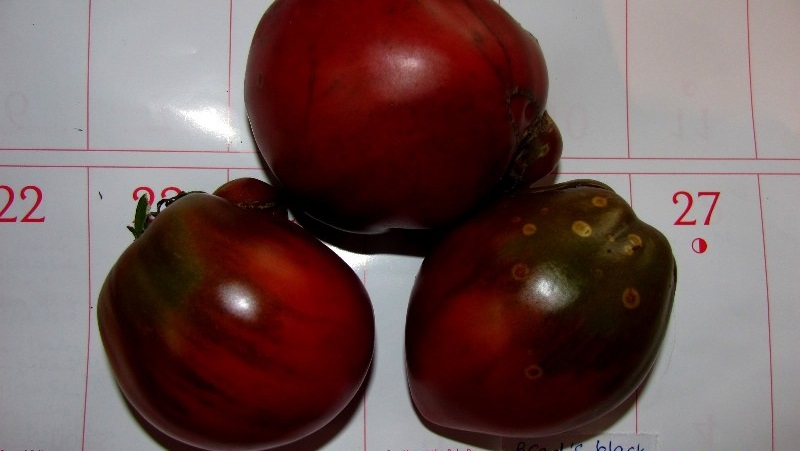
Main characteristics
Tomato Black Heart Breda is interesting not only for the unusual color of the fruit. It will be appreciated by gardeners who prefer sweet and high-yielding varieties.
Description of the characteristics of tomatoes Black Heart Delirium:
| Parameter | Indicators |
| Bush type | The variety is indeterminate. The stem is strong, powerful, erect. Reaches a height of 1.8 m. The bushes are not spreading. Covered with lots of greenery. Leaves are thin, light green, without pubescence, drooping. The first inflorescence is laid at 6-8 leaves. Fruits are formed in clusters on each tier. More than 6 fruits are collected in one brush. |
| Growing method | In the warm and central regions of our country, tomatoes are grown in open and protected ground. In the north, they are planted in greenhouses. |
| Yield | High. From 1 sq. m collect more than 20 kg. tomatoes. |
| Fruit | Large. One weighs on average 300-500 g. There are specimens weighing 1000 g.The outside is burgundy or pink, with brown, dark brown and purple spots. Inside the berries are dark pink, with areas of marsh and brown color along the edge, and light spots near the seed chambers. There is no green spot at the base. The entire surface of the fruit is ribbed. Irregular round or oval shape. The taste is sweet, with fruity notes, the aroma is pronounced. There is a lot of pulp, it is dense and juicy. They have many small chambers, with few seeds suitable for planting. |
| Transportability | High. Tomatoes have a tough skin that allows them to be transported over long distances and stored for more than a month. |
| Ripening terms | Mid-season variety. The first crop is harvested 100-115 days after sowing the seeds. |
| Disease resistance | Resistant to most tomato diseases. Resistant to late blight. Not immune to vertex rot. |
Growing seedlings
Tomato seedlings begin to grow 2 months before planting them in a permanent place. The time of sowing seeds depends on the climate of the region. So in the southern and central regions, seeds are sown in March, and in the northern ones in early April.
We prepare the planting material
Most growers process Black Heart Breda seeds in the factory. Information on whether the planting material is etched is indicated on the package. Seeds that have been disinfected are marked in orange and green.
If you use your own seeds or untreated purchased planting material, be sure to carry out the processing procedure. To do this, use a light pink solution of potassium permanganate, hydrogen peroxide, soda solution or aloe juice.
To test the seeds for germination, they are soaked in a saline solution (1 tsp of salt in 1 tbsp. Of water) for half an hour. Floated specimens are considered unsuitable for planting.
To accelerate seed germination, they are soaked in osta stimulants. Purchased preparations additionally protect plants from infections and increase their resistance to adverse environmental conditions.
Growth stimulants:
- "Epin". Take 3 drops of the product for 100 ml of water. In this composition, the seeds are soaked for 8 hours. The drug is non-toxic, goes well with potassium permanganate.
- "Zircon". Take 2 drops of the drug in a glass of water. The planting material is soaked in the product for 10 hours. Zircon is often combined with Etamon.
- "Sodium humate". 300 ml. water take 1 g of powder. The composition is insisted for 10 hours. 100 ml of the resulting liquid is diluted with 900 ml of water. The seeds are soaked for 6-8 hours.
Advice! Gardeners use honey water as an alternative to purchased growth stimulants. For its preparation for 1 tbsp. water take 1 tsp of honey. In this tool, the seeds are soaked for 12 hours.

Preparation of soil mixture and containers
The soil for tomatoes is chosen light and nutritious. A properly formulated mixture is easy to obtain from the store. Make soil for tomatoes and yourself.
To prepare a soil suitable for seedlings, black soil and humus are mixed in equal proportions. The same amount of river sand or sawdust is added to the resulting composition.
Both purchased and homemade soil must be disinfected before use. There are several options for disinfecting soil for seedlings:
- calcining the soil in the oven at 100 degrees;
- watering the soil with boiling water through a container with holes;
- watering the soil with a strong solution of potassium permanganate.
Usually seed sow in one large container. Plants dive into pots with a volume of at least 300 ml. For this, both purchased and homemade containers are suitable.
The container for sowing seeds must be disinfected by soaking in a strong solution of potassium permanganate.
Three ways of sowing seeds
There are several ways of sowing seeds for seedlings. The list contains the most popular ones:
- Sowing seeds in one container. The soil is poured into the boxes so that at least 3 cm remains to the edge. The seeds are laid out in rows.The distance between the seeds should be 1.5 cm, and between the rows 3 cm. The planting material is covered with a centimeter layer of earth. After that, the soil is moistened, covered with foil and placed in a warm place.
- Peat tablets. The blanks are folded into a deep container with the hole down and filled with boiling water. Water is added as the tablets increase in size. When the blanks are swollen, the seeds are placed in the peat with a toothpick, deepening by 1 cm. The tablets are folded into one deep container with the hole up, covered with a film and removed to a warm place.
- Growing seedlings without land. The bottom of a deep container is covered with several layers of napkins or toilet paper, which is soaked in warm water. Seeds are spread on it in rows. From above, they are covered with several more layers of paper, which is sprayed from a spray bottle. The container with seeds is covered with foil and removed to a warm place. When the cotyledon leaves appear, the seedlings dive into individual containers.
Seedling care
High-quality seedlings are the key to good survival of tomatoes after planting them in open ground. Therefore, it is important to properly care for the plants at this stage:
- When the seeds germinate, the film is removed and the containers are placed in a well-lit place. Lack of sunlight is compensated for with fluorescent lamps. If the daylight hours of seedlings are less than 16 hours, it stretches.
- Plants dive after the appearance of 2 true leaves. The opinion of gardeners about whether to pinch the central root when transplanting tomatoes into individual containers was divided. Some believe that this will contribute to the development of a stronger root system. Others think that pinching the root is just additional stress for plants, slowing their growth.
- The soil is moistened as it dries with warm water. The liquid should not come into contact with plant greens. Loss of turgor indicates both excess and lack of straining.
- The seedlings are fed 3 times. The first time after picking tomatoes into separate containers, the last one 3 days before they are planted in open ground, the second time between 1 and 3 fertilization. Biohumus, formulations with phosphorus and growth stimulants are used.
- 14 days before picking tomatoes to a permanent place, they begin to harden. To do this, the seedlings are taken out on the balcony or outside in the warm season. Start with a minimum time spent in the fresh air, gradually increasing it.
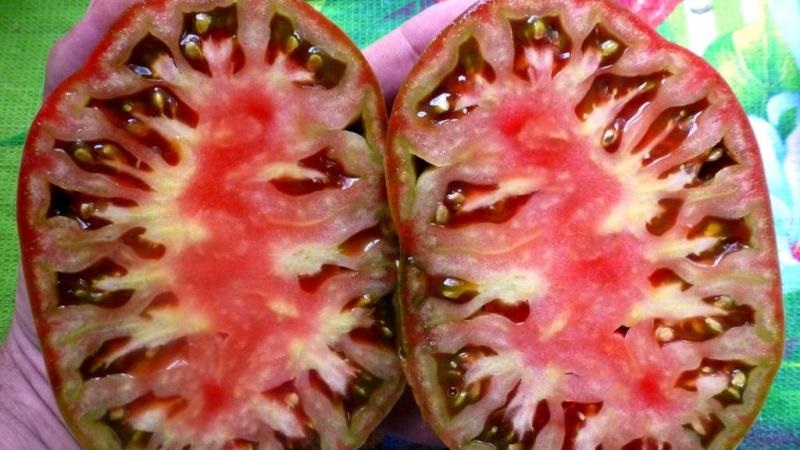
Agrotechnics
Tomatoes are planted in the ground when the soil warms up and the danger of frost has passed. The picking time depends on the climatic characteristics of the region. The colder it is in your area, the later the seedlings are transplanted to their permanent location.
3 days before the pick, the seedlings are watered and fed. This will allow her to better settle down in a new place.
Planting seedlings in a permanent place
For tomatoes, choose the sunniest place on the site. It should not be near the potato plantings. The worst predecessors for tomatoes are nightshade crops, the best are legumes, cabbage, onions and cucumbers.
In autumn, the soil is cleared of residues of cultivated and weed plants. It is fertilized with humus. To reduce acidity, dry lime is scattered over the beds.
In the spring, the soil is dug up and cleaned of plant roots. To enrich its composition, ash is used from chicken manure. For disinfection, the soil is watered with a solution of copper sulfate.
The holes are dug in rows in a checkerboard pattern. For 1 sq. m plant no more than 3 plants. A wooden support is immediately placed near each hole.
Tomatoes are placed in the holes along with a lump of earth. Grooves fall asleep with soil, which is compacted. Then the tomatoes are watered, spending 1 liter of warm water for each plant. The next watering is after 2 weeks.
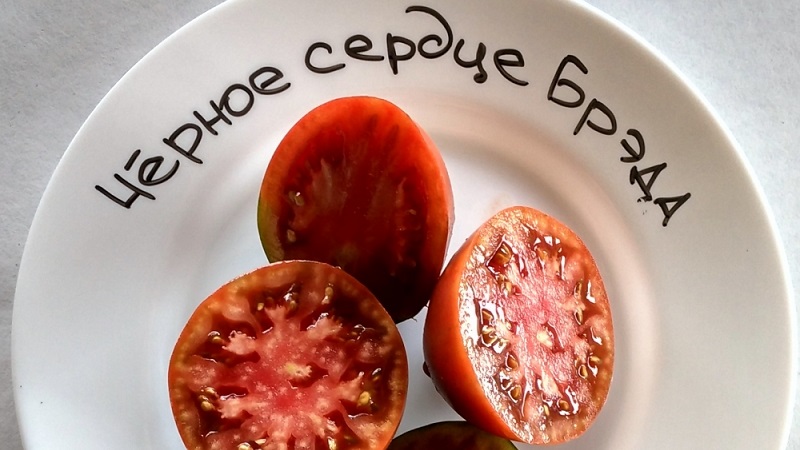
Tomato Care Black Heart Delirium
The tall bushes of the Black Heart of Delirium need a garter. Plants are attached to the support as they grow. The heaviest hands with fruits are tied separately.
Form a tomato into 1-3 stems. The more stalks remain, the smaller the fruits will be, and the later they will ripen. When plants are formed into 1 stem, it is possible to get the largest fruits, but the yield in this case will be lower.
When pinching, damaged and lower leaves are removed. Ugly and small inflorescences also need to be removed from the bush.
Water the tomatoes after 2 days. At least 2 liters of warm settled water are consumed per plant. The liquid should not get on the ground part of the bush.
Tomatoes are fed 3-4 times per season. They use organic and mineral fertilizers, alternating between them.
The plants are sprayed with foliar dressing twice a season. This speeds up the formation and ripening of the fruit.
The nuances of growing tomatoes
Experienced gardeners know several nuances that will help to get the maximum yield of the Black Heart of Brad.
Below are the most important tips:
- Pay special attention to feeding tomatoes. Tomatoes are fed twice a season with mullein solution, yeast fertilizers or biohumus. Complex mineral fertilizers are purchased in stores or prepared independently. The last dressing should contain potassium and phosphorus.
- Before feeding the tomatoes, the plants are watered with plenty of water. Otherwise, fertilizers can cause root burns.
- For garters tomatoes use synthetic thread. Natural material will start to rot, causing plant diseases.
- Step sons tomatoes once a week.
- In one procedure, no more than 3 leaves are removed.
Diseases and pests
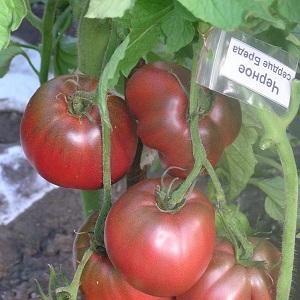 Variety Black Heart Breda is not susceptible to most tomato diseases. He is not sick late blight... However, according to gardeners' reviews, it is often affected by apical rot.
Variety Black Heart Breda is not susceptible to most tomato diseases. He is not sick late blight... However, according to gardeners' reviews, it is often affected by apical rot.
To reduce the likelihood of plant contamination, all tools that interact with them are disinfected. For this, seeds and soil are disinfected.
Be sure to follow the rules for watering and pinching. Otherwise, the resistance of plants to infections will decrease.
The bushes are sprayed weekly with a calcium nitrate solution to prevent apical rot.
To prevent damage to tomato bushes by pests, they are sprayed with soapy water and dandelion decoction. Large insects are collected by hand.
Cultivation of the variety in open and protected ground
When grown in a greenhouse, Black Heart Delirium tomatoes grow taller and produce a richer crop. Therefore, this variety is more often cultivated in greenhouses.
Before planting tomatoes in protected ground, the walls of the room are treated with copper sulfate. To ensure optimal humidity, the greenhouse is regularly ventilated by opening the vents.
When growing tomatoes outdoors, they must be protected from frost. To do this, they are covered with foil at night in the first 2 weeks after the pick. Further, this method is used during cold snaps.
In the open field, the rows are mulched with hay, humus or straw. This protects the roots from freezing, slows down the growth of weeds and prevents the development of pathogens. Mulch also acts as an additional fertilizer.
Harvesting and application of the crop
The first fruits of the Black Heart Breda are harvested at the end of July. The fruits are removed with brushes or individually, depending on the amicability of their ripening.
Green fruits ripen at home. To do this, they are placed in a warm place.
The fruits are used for preparing salads, second and first courses. The variety is not suitable for canning.
Advantages and disadvantages
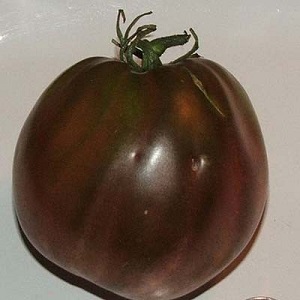 The advantages of the variety:
The advantages of the variety:
- high productivity;
- high content of anthocyanin;
- resistance to late blight and other tomato diseases;
- sweet taste;
- large-fruited;
- the possibility of growing in open and protected ground;
- unusual appearance of the fruit;
- the possibility of using seeds from fruits for planting.
Disadvantages:
- the need for garter and pinching;
- instability to top rot.
Gardeners reviews about the variety
Tomatoes Black Heart Breda are popular among domestic gardeners. Reviews speak of the wonderful taste and high yield of this variety.
Anna Krikunova, Krasnoyarsk:“I grew the Black Heart of Delirium in a greenhouse. Formed bushes into one stem. I used nitrophoska and chicken droppings as top dressing. The variety pleased with its yield. From 1 sq. m collected 18 kilograms for sure ”.
Elena Sergeeva, Zheleznogorsk: “Last year, she planted the Black Heart of Brad. I wanted to try black tomatoes, but they turned out to be brown rather than black. However, in the photo they are just like that. I liked the taste. The yield is good. But I want to try real black tomatoes. "
Conclusion
The Black Heart of Delirium is a variety of black-fruited tomatoes. Its fruits are distinguished by their intense sweet taste and unusual color. In addition, the berries contain anthocyanin useful for the body.
Raising a Black Heart of Delirium is not difficult. By regularly feeding and feeding him, you will avoid any difficulties with his leaving. Therefore, the variety is ideal for gardeners who have decided to try growing black tomatoes for the first time.